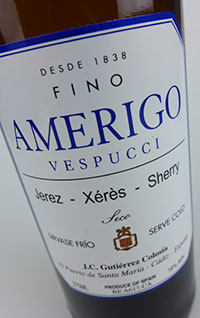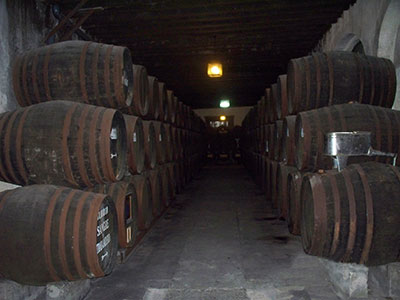Fino's Sweet Spot (Revisited)
Gutiérrez Colosía Fino Amerigo 375ml
Gutiérrez Colosía is the last surviving bodega on the banks of the Guadalete River, a sweet spot for Fino. A few years ago, I was poured an old Fino that they've never released.
I did everything I could to convince them to bottle some. It took awhile, but last year it finally happened.
We offered Gutiérrez Colosía Fino Amerigo almost one year ago (see the original offer below.) Having watched sherries like Fino Inocente, the La Bota Finos and Manzanillas and Barbadillo's En Ramas improve with a year in bottle, I made it a point to buy some extra Amerigo so it could age.
It's evolved very well; it's gained depth and even more saline minerality.
 |
I encourage you to check out last year's offer for more detail. I'll just provide the essentials here. El Puerto Santa María, along with Jerez and Sanlúcar, is the third town in the "sherry triangle." Old sherry books are littered with mentions of El Puerto as being the ideal place to raise fino.
The easy comparison to draw is to the fino's of Sanlúcar de Barrameda that are called Manzanillas. Both areas have cooler temperatures and higher humidity than Jerez due to a close proximity to the sea. When it gets hot in Jerez, people head to El Puerto for relief. In these climatic conditions, flor thrives and the wines develop a delicacy and sea breeze quality that's beautiful and distinctive.
Within El Puerto Santa María, Gutiérrez Colosía is located in an especially cool and humid spot on the banks of the Guadalete River very close to where it empties out to the Bay of Cádiz. This makes for a particularly elegant and saline fino. It oversimplifies things, but more or less we're talking about what amounts to a Grand Cru for fino.
That brings us to the Fino Amerigo. It's sourced from a solera where the average age is around six years, the older range for fino. The age gives the wine more intensity, more complexity and really amplifies the uniqueness of El Puerto and Gutiérrez Colosía. They bottled the Amerigo "en rama" (with minimal filtration) and this preserves a lot of texture and complexity.
 |
This is all to say that Fino Amerigo beautifully displays what makes fino raised in El Puerto Santa María so special. There are saline notes along with citrus and floral notes that are incredibly aromatic and complex. Above all, there's an intricate delicacy, a creamy tenderness that seems to belie the wine's long persistent finish.
It's a beautiful Saturday, so I'll wrap this up. To close, I'll just say that this is really starting to sing. Whether this is a first-go or a second look, the value and the beautiful expression of El Puerto's uniqueness makes this something to grab at least a couple bottles of.
To order, reply to offers@crushwineco.com or call the store at (212) 980-9463.
Joe Salamone
Wine Buyer
Crush Wine & Spirits
=====================================================================================================
November 2012 offer:
Gutiérrez Colosía Fino Amerigo is one of the most delicate, expressive and complex Finos that I've tasted. More important, it was the most glorious representation of Fino from the town of El Puerto Santa María that I've encountered.
That was back in 2010 and I've been working on getting it bottled since. It's a great wine, and just an awesome representation of variety that exists across the Fino category.
The Grand Cru comparison is reductive, for sure. However, it quickly gets to a simple fact: In Sherry, the bodega has its own terroir and Gutiérrez Colosía's is in a sweet spot.
When you look through old Sherry books, you always come across references that the town of El Puerto Santa María is the ideal place for raising Fino. The easy comparison to draw is to the Fino's of Sanlúcar de Barrameda that are called Manzanillas. Both areas have cooler temperatures and higher humidity than Jerez due to a close proximity to the sea. When it gets hot in Jerez, people head to El Puerto for relief.
In these climatic conditions, flor thrives and the wines develop a delicacy and sea breeze salinity that's beautiful and distinctive. Within El Puerto Santa María, Gutiérrez Colosía is located in an especially cool and humid spot on the banks of the Guadalete River very close to where it empties out to the Bay of Cádiz.
As quoted in Peter Liem's and Jesús Barquín's Sherry, Manzanilla & Montilla, Juan Carlos Gutiérrez says, "In Sanlúcar they talk about being close to the sea, but nobody is closer to the sea than we are."
When you visit Gutiérrez Colosía, their prime location becomes obvious. The floors of bodegas are usually covered with albero, a sandy, chalky dirt that's used in bull rings and releases moisture very well. To maintain the proper temperature and humidity for the flor to thrive, people spray the albero floors. There's no albero soil on the floors at Gutiérrez Colosía. Instead, there are large tiles and they rarely need to spray.
In many ways, the story of Gutiérrez Colosía's Fino Amerigo tells the story of just how fragile this region is and how many treasures exist unknown in the bodegas.
Despite being in the sweet spot, Gutiérrez Colosía is the last surviving bodega on the banks of the Guadalete River. Sherry has been in a state of crisis for decades and many small bodegas have folded.
As I mentioned earlier, the old Fino that makes up Amerigo had never been commercialized. (Many bodegas in Sherry country are filled with special wines that are virtually unknown.) Gutiérrez Colosía were just maintaining the wine because the flor had continued for a particularly long-time, six years. There was no real economic incentive to keeping the wine, but they felt it was special.
And I'm very happy they did. Fino Amerigo beautifully displays what makes Fino raised in El Puerto Santa María so special. There are saline notes along with citrus and floral notes that are incredibly aromatic and complex. Above all, there's an intricate delicacy, a creamy tenderness that seem to belie the wine's long persistent finish.
Gutiérrez Colosía is well known for their Fino Elcano, which is a younger Fino aged somewhere around four years of age and, like most Finos, goes through a fairly aggressive filtration process. Their Fino Amerigo boasts the added complexity, palate presence and finesse that comes with long aging.
Fino Amerigo is also bottled En Rama, or with minimal filtration. Aggressive filtration of Finos and Manzanillas became popular in the 70s when young, crisp Finos were in demand. Something is definitely lost when Finos are highly filtered. En Rama versions always have more complexity, great texture and a dynamism that the very filtered versions don't.
For people who've been embracing Sherry, Fino Amerigo is a must. For people who love good wine and great value, this is recommended. It's a compelling example of just how graceful, delicate and complex Fino can be. Not to mention, possibly the finest example of a special place to raise Fino.
Joe Salamone
Wine Buyer
Crush Wine & Spirits
